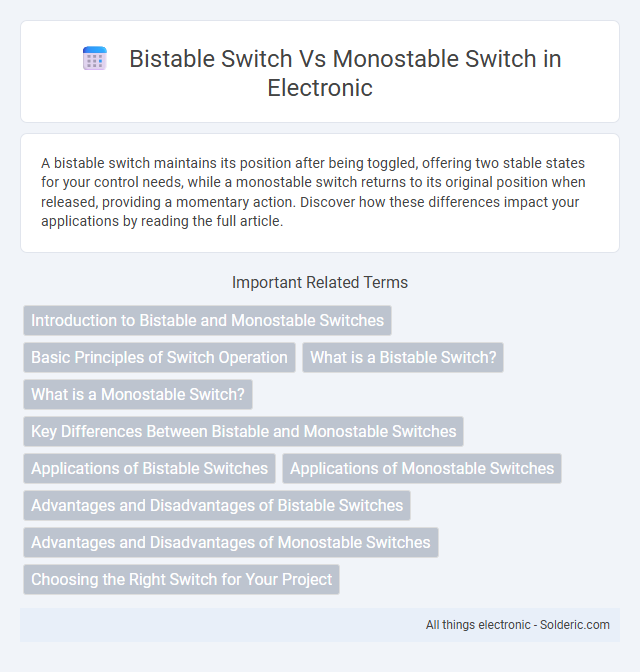A bistable switch maintains its position after being toggled, offering two stable states for your control needs, while a monostable switch returns to its original position when released, providing a momentary action. Discover how these differences impact your applications by reading the full article.
Comparison Table
| Feature | Bistable Switch | Monostable Switch |
|---|---|---|
| Definition | Switch with two stable states, maintains position until toggled | Switch with one stable state, returns to original position after activation |
| State Retention | Maintains position after actuation | Automatically returns to default position after actuation |
| Use Case | Toggle switches, memory circuits | Push buttons, momentary contact switches |
| Operation | Toggles between ON and OFF states | Activates temporarily when pressed |
| Example | Light switch, flip-flop circuit | Doorbell button, reset button |
| Energy Consumption | Low, no power to maintain state | Consumes power only during activation |
Introduction to Bistable and Monostable Switches
Bistable switches maintain two stable states, allowing you to toggle between on and off positions without continuous energy input, ideal for applications requiring memory retention. Monostable switches, in contrast, return to a single stable state after activation, commonly used for momentary functions like push buttons or timers. Understanding the fundamental operation of both switch types aids in selecting the right component for your electronic circuit design.
Basic Principles of Switch Operation
A bistable switch maintains two stable states, ON and OFF, allowing it to retain its position until an external force changes it, ideal for applications like memory storage and toggle switches. A monostable switch has one stable state and returns to that state automatically after being triggered, commonly used in timing circuits and momentary push buttons. Understanding these basic principles helps you choose the right switch for your electronic project based on stability and functionality requirements.
What is a Bistable Switch?
A bistable switch is an electronic component that has two stable states and can maintain its position indefinitely without continuous power. It is commonly used in applications like memory storage, toggle operations, and relay controls where the switch must stay in either the ON or OFF state until toggled again. Unlike a monostable switch, which returns to its default state after activation, the bistable switch holds its state, making it ideal for latching functions.
What is a Monostable Switch?
A monostable switch, also known as a one-shot timer, is an electronic circuit that has one stable state and temporarily switches to an unstable state when triggered. It automatically returns to its stable state after a predetermined time interval without additional input. Monostable switches are commonly used in pulse generation, timers, and debounce circuits to create fixed-duration output pulses.
Key Differences Between Bistable and Monostable Switches
Bistable switches maintain their state after being actuated, requiring a second action to change it, making them ideal for applications needing stable on/off positions. Monostable switches return to their original state automatically once released, suited for momentary operations like doorbells or push-to-talk buttons. Key differences include bistable switches having two stable states versus the single stable state of monostable switches and their distinct mechanical behaviors affecting circuit design and control logic.
Applications of Bistable Switches
Bistable switches are commonly used in applications requiring stable, memory-retentive states such as toggle light switches, flip-flop circuits in digital electronics, and relay control systems. They provide reliable on-off control without continuous power consumption, making them ideal for energy-efficient designs in automation and home appliances. Their ability to maintain position after actuation is crucial in settings like industrial machinery controls and electronic voting systems.
Applications of Monostable Switches
Monostable switches are primarily used in timing applications such as pulse generation, debounce circuits, and timer delay functions in digital electronics. They are essential in triggering single, precise output pulses from a single input event, commonly found in alarm systems, timer circuits, and flip-flop reset functions. Their ability to provide a stable output for a predetermined time makes them invaluable in sequential logic design and automated control systems.
Advantages and Disadvantages of Bistable Switches
Bistable switches maintain their position without continuous power, offering energy efficiency and state retention ideal for memory devices and toggle functions. Their complexity and higher cost compared to monostable switches can limit usage in simple applications requiring momentary operation. Bistable switches provide reliable switching between two stable states but may introduce mechanical wear over time due to repeated switching.
Advantages and Disadvantages of Monostable Switches
Monostable switches offer advantages such as simple design, fast response time, and automatic return to the default state after activation, making them ideal for applications requiring momentary control. However, their limitation lies in the inability to maintain the switched state without continuous input, which can be less efficient for scenarios needing sustained activation. Your choice between monostable and bistable switches should consider these operational traits to match the switching behavior needed.
Choosing the Right Switch for Your Project
Bistable switches maintain their position until toggled again, making them ideal for projects requiring a stable on/off state without continuous power consumption. Monostable switches return to their default position immediately after being pressed, perfect for momentary actions like triggering alarms or resets. Understanding your project's needs for either a sustained or momentary activation helps ensure you choose the right switch to optimize performance and reliability.
bistable switch vs monostable switch Infographic

 solderic.com
solderic.com